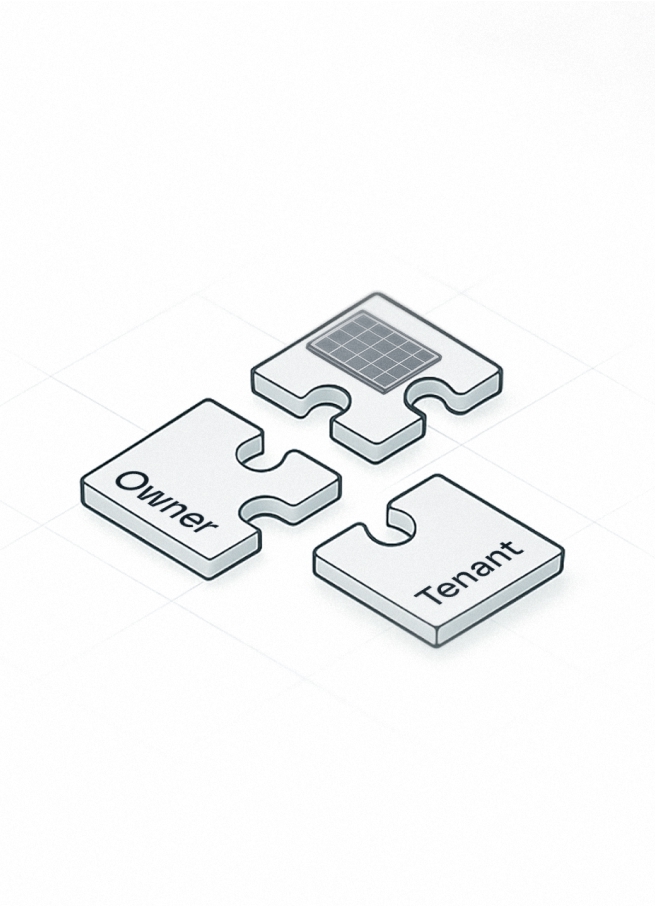Virtual Net Metering Enables Solar on California Buildings

With the popularity of solar growing every year, you likely already know the many benefits of renewable energy–not just for lowering your utility bill but also for the environment. The challenge comes with understanding the policies and utility tariffs, particularly Virtual Net Metering (VNEM), around shared solar and multifamily solar billing. Ivy is a leading multifamily solar enabler and a trusted advisor to property owners and managers considering sustainable energy solutions in California and across the U.S. This blog will cover exactly what you need to know about how VNEM works for you. No need to spend hours reading articles on the internet or the fine print from your utility company.
What is Virtual Net Metering?
You may have heard of it by a couple of different names and acronyms. Virtual Net Metering (VNM or VNEM), are all the same thing. It is the tariff arrangement that allows a property to share a solar system’s energy credits with multiple meters. This applies to sharing solar power with multifamily residents or with multiple tenants of a commercial building. The intent of VNEM is to help tenants receive the direct benefits of the building’s solar system, rather than all of the benefits going to the building owner. It is a simple yet powerful solution that brings solar benefits to those without home ownership.
The Purpose of Virtual Net Metering
Prior to VNEM, the multifamily property owner could benefit from a solar PV system because it was easy to connect the system to a common area load. But that left resident load reduction value on the table, and it was incredibly difficult to share generated power across multiple different meters. Furthermore, it was nearly impossible to make sure you did so in an equitable way that ensured every participating resident benefited equally according to their energy used. This meant that the financial side of multifamily solar typically didn’t make sense for property owners to make the investment.
Enter virtual net metering, which initially began as a pilot program under the CSI Multifamily Affordable Solar Housing (MASH) Program. Their goal was to create a system that would allow affordable housing property owners to share the benefits of solar with low-income residents. It proved to be so successful that the program was expanded and VNEM was created, allowing all multifamily residents the opportunity to benefit from clean energy. It also enabled property owners to monetize solar assets to get a return on the investment, while avoiding the administrative challenges traditionally associated with multifamily solar.
Virtual Net Metering Benefits for Multifamily Properties
Improves Accessibility and Affordability of Solar Energy
Virtual net metering makes solar energy on multi-unit buildings accessible and attainable. It provides multifamily residents access to clean energy and solar savings that they didn’t have access to before. A lower utility bill can make a huge difference for residents of low and middle-income groups. Disadvantaged communities and renters do not have to be left out of the clean energy transition with VNEM.
Creates an Opportunity for Additional NOI
VNEM doesn’t just benefit residents, it also benefits multifamily owners. It does so by creating an opportunity for multifamily property owners to generate an additional net operating income (NOI) by sharing the benefits of solar with residents. Multifamily owners using Ivy’s Virtual Grid platform generate $500 to $1200 per unit per year in additional NOI. If investing in solar can pencil out for a multifamily property thanks to the new NOI, then more owners can invest in a shared solar system. The easiest way to do this is with Ivy’s solar billing software, which uses utility-grade monitoring data to do all the work of equitably distributing solar credits to residents with a transparent monthly bill.
Increases Resident Retention and Attraction
While multifamily solar has grown over the last decade, the number of apartment communities with renewable energy is still a small portion of the market. Having a shared solar asset that provides savings on resident utility bills in addition to being clean energy boosts your property’s market value. Sustainable living and green options are in high demand by consumers today. Not to mention, helping residents lower their utility bills is one more reason for them to renew their lease with your community when their time is up.
Raises Property Values
With California’s big climate goals, policies continue to shift toward mandating cleaner energy solutions. Title 24 already requires new construction to install onsite solar, and soon will expand that mandate to existing buildings. The addition of solar panels increases your ESG (Environmental, Social, and Governance) and LEED (Leadership in Energy and Environmental Design) ratings. So, if you ever decide to sell your multifamily real estate, a solar asset sharing VNEM credits with residents will only increase the value of your property.
Protects from Rising Energy Rates
Did you know that adding a solar asset to your property means your energy rates are locked in? This is a massive benefit in California because we not only have some of the highest electricity rates in the country, but also, they are always increasing. For example, San Diego Gas and Electric raised their baseline rates by 106% in the last ten years. And a study found that California electricity prices have been rising at three times the national average rate of increase since 2017. Thanks to VNEM, multifamily solar provides a hedge against these increases for years to come.
You Don’t Have to Navigate VNEM Alone
As mentioned earlier, we’re happy to be your guide to VNEM or any other aspect of considering multifamily solar, no matter where you are in the process. There is a lot to consider beyond VNEM, including the Title 24 mandates, building decarbonization incentives, renewable energy tax credits, and other benefits you may qualify for under the new Inflation Reduction Act.
Our team has experience with it all. We have been on the front lines working with California policymakers and regulators to ensure that the future of multifamily solar remains bright. Between the benefits of VNEM and our Virtual Grid software, there is no reason to not invest in multifamily solar. Your next step? Learn more about Ivy and how we can support you by scheduling a demo with one of our team members.





